Understanding Solar Hot Water
This article is about solar hot water which is using the sun's energy to heat cold water. We talk about a specific type of solar hot water technology called solar evacuated tube. It's kind of a newer technology in the United States, especially in Florida. You'll see this a lot more in northern states and a lot of other countries such as Germany, France, England. This is a really popular design that's used in the northern climates. One of the reasons is that with lower wind loads the wind can go in between the tubes and also that the snow can fall in between the panels increasing their efficiency.
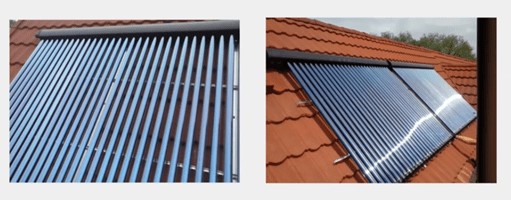
The panels that you see on this picture right now are not electricity producing panels. These tubes are made out of copper and there's usually a gas freon or just air on the inside of these tubes or sometimes even a liquid depending on the manufacturer and the type of evacuated tube or solar hot water panel. Sun will heat those tubes up. The black metal bar at the top heats up the water flows from left to right or right to left. Thus this is an extremely efficient system. It's actually more efficient number-wise than using solar electric panels to heat hot water.
Hot water and Electric Bill
One of the things that shocks most people is that hot water is usually the first or the second largest part of the electric bill. Most people have electric water heaters standard in their house and it takes a lot of electricity to heat even one gallon of water. So when we do an analysis of a customer's electric bill whether they're residential or a commercial facility usually twenty to thirty three percent about one third of that bill is usually hot water. When we install a solar hot water system properly, we pull all the permits, do all the engineering, make sure that won't blow off the top of your house, make sure everything is legally done, we have the city or county or building inspector come take a look at it and once it's hooked up to your hot water tank over the next few years that system should save you twenty to thirty three percent of money. This is because the hot water from that solar system is extremely efficient and it can keep up with that electric backup or the previous electric hot water tank. We usually take someone's electric bill, look at the last point and multiply that by 30%. That usually tells us a very good estimate about how much a solar hot water system will save you.
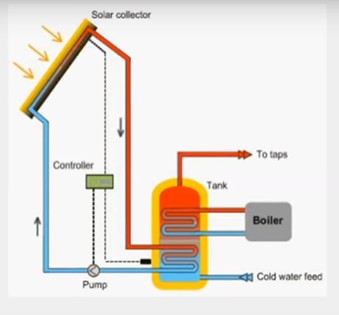
Now another question that we have is how does this work? Above there is a diagram that shows the solar collector with the hot water tank. This system is called an independent solar thermal system. What this means is that hot water basically comes in too cold into the solar hot water panel and then moving down the hot water goes into a heat exchanger inside the tank. So this is a special type of tank that will be needed to install and is included with this package. It basically heats up the already existing water inside our hot water tank. This picture also has the back up like a boiler or an instant hot or other electric or natural gas water heater. We can hook that up to the system for backup just in case it's cloudy for like a week straight or we don't get a lot of sun. Even still the solar collector should keep up with heating up your hot water tank.
The solar collector also has a controller which controls the pump which can actually be solar powered as well. For most installs, we don't have the ability to put a PV panel there but in case of say residential customer that wants everything off-grid we can definitely put a PV panel that powers that pump. See the dotted line on the lower right of that controller that goes to the hot water tank. Say the hot water tank drops to below 80 degrees or 90 degrees Fahrenheit then the customer can actually set that on the controller and the pump will turn on and take the cold water up to that solar collector. The Sun will heat that up and it'll drain back down or move down with the flow and heat up that tank. The controller has a temperature differential device inside of it that determines when it turns on.
When it's nighttime we definitely can do different types of systems depending on what type of tank, how many solar collectors you have, how many controllers we've done, installations where we've had. We want to install solar collectors perpendicular with the sun's rays as much as possible to minimise heat loss. In Florida we typically install anywhere from 20 to 30 degrees angle or we try to make it as flat as possible with the roof.
Solar Thermal Water Heating will substitute Electricity in Future
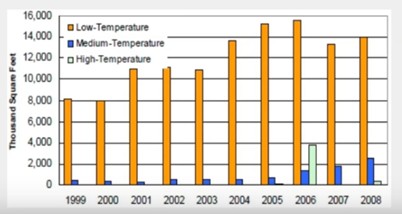
As more and more people find out about the efficiency of solar thermal, the market is increasing every single year. This graph unfortunately only goes up to 2008 but this is the best data that we could find. We have different types of solar thermal water heating and it's usually divided into solar thermal for your home, solar thermal for your commercial and then solar thermal for power plant generation.
Investing in Future Energy Consumption
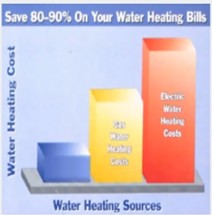
The return on investment is the number one selling point of solar hot water panels. When you install a solar hot water system, the savings are immediate the day that turns on. For a typical price of a solar hot water system you're looking at anywhere from three thousand dollars all the way to higher-end seven thousand dollars.You also get a thirty percent federal tax credit in the United States and its territories. If you're a business customer you can depreciate that over a period of six to seven years so it'll fully pay for itself.
Evacuated Tube vs Flat Plate Models
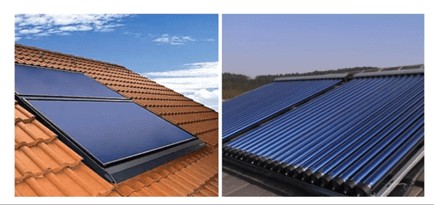
In the picture, there are two different pictures of a solar hot water panel. On the left hand side is a picture of a flat plate collector. It's one solid piece of glass. The picture on the right is the evacuated tube. So two very different technologies but they operate in almost the same way. They both use copper and they both have water flowing through them. The flat plate and the evacuated tube are roughly the same price. The evacuated tube is much easier to install whereas the flat plate is one solid collector which can weigh 200 to 300 pounds depending on the size. It takes a heavier lift and a crew of at least two to three to get a flat plate collector up there whereas the evacuated tube has individual tubes. You just have to screw those in so it's a lot less roof penetration. For the flight plate collector you have to remove all those tiles whereas for evacuated the shingles will still exist underneath the panel. Their efficiency is roughly the same. In colder weather snow the evacuated one will actually perform a slightly better as the snow slips between the tubes and there's a lower chance of wind shear. For flat plates there’s a good chance that the snow will stay on the solar flat plate and not fall off until it heats up.
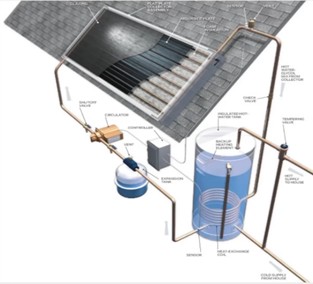
The picture above shows you a cutaway of a flat plate collector. There’s the glass, the metal absorbing plate and the copper tubing inside. You have safety devices inside the circuit so that either the water vents out or the heat vents out so no one will be hurt. They also have the pump which shows the controller. We have to figure out where we're mounting that solar hot water panel, how long the copper run is going to be, if the solar thermal panel has a powerful enough motor to move that water and also that everything is heavily insulated because we want to minimise the heat loss through that copper piping. The more we minimise the copper run, the more efficient the panel is as more hot water will arrive and also will be a cheaper install.
If we could replace the flat plate collector with the evacuated tube it would look exactly the same. Just the orientation of the copper piping on the top would be slightly different because there are two connections on an evacuated tube. Right at the top we have water flowing basically perpendicular with the tubes. There is also a heat dissipator device which acts like a radiator just in case the evacuated tube overheats.
Frequently asked questions about Evacuated Tube Collectors

● Are these new?
No, the technology is about 20 years old. The tubes were developed in Germany by Daimler-Benz Aerospace in cooperation with a solar energy research company.
● How many tubes do you need and how much space is required?
For DHW we typically use 4 tubes per person, which assumes 20 gal/person/day usage rate and raising the water temperature from say 55 F to 120 F at a minimum. A 2-person family would need a 1/5-8 tube collector and a 50 gal storage tank. A 4-person family needs a 1/5-16 tube collector and an 80 gal tank. The 16-tube collector is just over 6ft wide (75.6") and about 7 ft long (83")
● How can you tell if you have lost the vacuum?
All tubes now being delivered have a silvery coating on the inside at the bottom of the tube. When vacuum is lost, this coating depletes and the tube becomes clear. Older style tubes did not have this feature and you had to rely on observing a build-up of condensation inside the tube as an indicator of vacuum loss.
● Will the glass break in a hailstorm?
The tubes are manufactured and tested to withstand 35mm (1.38 inch) diameter hailstones. The glass is low-iron tempered glass that is 2.5mm thick.
● Can I heat my house with these?
Yes, provided that the home is well insulated, thereby having a low heat loss to the environment. There are no rules of thumb for sizing a space heating array based on square footage of a house. You have to know the heat loss, design temperatures, weather data, and solar radiation available to estimate the size. It will be larger than the DHW component alone.
● What is the life of a tube?
The statistical "mean life to failure" is 15 years.
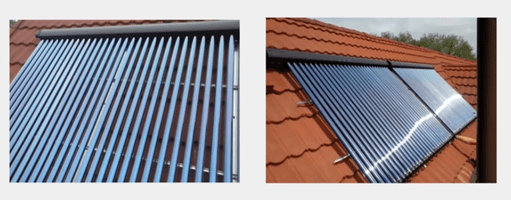
Please give us a message
DINGXIN story
One electric water heater branded as Dingxin, which has warmed Mr Chen for 22 years. In 1991,Mr Chen bought a new water heater and normally lived with it as long as 22 years in Wenzhou
The Family business
DINXIN ADVENTURE THROUGH 2 GENERATIONS, FROM THE START IN 1986 TO TODAY.
The family business
The founder –Dong Wanwen– started “Dingxin” (in Wenzhou in 1986, as one of the first water heater manufacture in China. With minimal resources he created the first vented water heater in Wenzhou. He has, during his 30 years in Dingxin, mixed friendly industry and home culture in a unique way and has given Dingxin the recognition as one of the earliest enterprises in china.
2rd generation –Eric Dong,is devoted to improving Dingxin’s products and processes and desires to build the company brick by brick,. The pioneering spirit lives on with product innovations featuring integrated solutions, ground-breaking material technology and added value for our customers.
Three main markets oriention of Dingxin:
• Northern China: Thanks to trust and confidence from our customers, Dingxin engages a attractive market share in North China over the last 30 years. Our products named as Dignxin delivers well-being and hotwater to two-thirds of all homes in the three north-east of provinces of china, with durable lifetime economy.
• OEM/EXPORT: We are proud to supply water heaters to various brands in the heating industry all over Europe,South America,South asia. OEM is an important part of our business because it inspires and motivates us to think innovatively, be flexible in our approach and challenge traditional mind-sets.
• Kitchen&bathroom branch: Dingxin focuses on the domestic market of kitchen&bathroom since 2016 and whose sales make up about 40% of the turnover and gives us a unique perspective and knowledge of related business lines and innovative marketing strategies which benefit all our customers.
DINGXIN story
One electric water heater branded as Dingxin, which has warmed Mr Chen for 22 years. In 1991,Mr Chen bought a new water heater and normally lived with it as long as 22 years in Wenzhou
Historic milestones
Dingxin launched a promise to replace the water heaters free of charge for those were purchased before 1995 and still normally used up to 2015. When Mr. Zhang saw this news,he immediately rushed to the Dingxin franchise shop of department store in Taiyuan city, Shanxi province. the Dingxin staff there offered Mr. Zhang for a free replacement service;
One electric water heater branded as Dingxin, which has warmed Mr Chen for 22 years. In 1991,Mr Chen bought a new water heater and normally lived with it as long as 22 years in Wenzhou .when Dingxin launched a campaign that every home could receive new water heater replacement installation service free of charge only if who purchased Dinxin water heaters before 1995 and still normally adopt it with over 22 years, Surely Mr Chen belongs to the ones who could received this fantastic service launched by Dingxin.
Mr. Zhu, in Dingxin franchise department, purchased two electric water heaters in 1988 and he spent ¥500 in all. When it comes to 2014, the two electric water heaters have been in its life time for 26 years and still have been in fantastic condition. The Dingxin promise to offer free replacement service of the two water heaters
In 1993, Mr. Wang purchased this water heater in franchise department of Tangshan city, Hebei province.and it is well in circulation for over 23 years, Dingxin offer free replacement service out of security considerations in 2015
Warranty Information
Dingxin warrants for 2 years from the date of purchase, that the Product will: i) conform to Dingxin approval specification, ii) be free from defects in materials and workmanship, subject to conditions below. All electric components carry a 2-year warranty
Scope
Dingxin warrants for 2 years from the date of purchase, that the Product will: i) conform to Dingxin approval specification, ii) be free from defects in materials and workmanship, subject to conditions below. All electric components carry a 2-year warranty.
The warranty is voluntarily extended by Dingxin to 5 years for the premium models. This extended warranty only applies to Products purchased by a consumer, that has been installed for private use and that has been distributed by Dingxin or by a distributor where the Products have been originally sold by Dingxin.
The extended warranty does not apply to Products purchased by commercial entities or for Products that have been installed for commercial use. These shall be subject only to the mandatory provisions of the law. The conditions and limitations set out below shall apply.
Warranty Information
Dingxin warrants for 2 years from the date of purchase, that the Product will: i) conform to Dingxin approval specification, ii) be free from defects in materials and workmanship, subject to conditions below. All electric components carry a 2-year warranty
Coverage
If a defect arises and a valid claim is received within the statutory warranty period, at its option and to the extent permitted by law, Dingxin shall either; i) repair the defect, or; ii) replace the product with a product that is identical or similar in function, or; iii) refund the purchase price.
Dingxin possess all property of any exchanged Product or component. Any valid claim or service does not extend the original warranty. The replacement received Product or part does not carry a new warranty.
Manufacturing
Excellent working condition & longer service life: no leakage, rust-free, high strength and strong resistance to corrosion
Tank comparison
COMPARISION BETWEEN SS TANK AND ENAMEL TANK
ENAMEL TANK
Porcelain Enamel Tank - is a trusted & proven technology for inner tank of water heaters. Used widely across the world, it is ideal for long life & trouble free performance in all kinds of water. More than 95% of water heaters produced worldwide are with enamel tanks. Corrosion protection is very good due to fusion of glass layer to metal.
SS TANK
Stainless Steel Tank - this is an outdated technology that manufacturers are moving out of now. Corrosion protection is very poor, particularly in hard water and due to poor welding quality.
SL Description Enamel Tank SS Tank
1 Protection Coating Porcelain Enamel -
2 Coating Type Inorganic None
3 Coating Thickness 250 - 400 microns None
4 Coating Adhesion Fused with metal None
5 Baking Temperature 850 deg C -
6 Life of the Coating Long life -
7 Usage Widely used Internationally Limited. In very few countries
8 Material Mild Steel Stainless Steel
9 Thickness 2.0mm 0.63
10 Rated Pressure 8kg/cm2 3kg/cm2 & 6kg/cm2
11 cathodic protection Magnesium Anode -
12 Hard water Suitability Good Poor
13 Corrosion Protection V.Good Poor-Average
14 Hot Water resistant V.Good V.Good
15 Approved Quality Standards BIS, IEC, DIN & UL BIS
HARD WATRT
As so common problem for millions of households across the country.Hard water means excessive dissolved minerals, specifically calcium and magnesium in tap water various in different countries.
Hard water is a negative impact because of much limescale it brings, Thus, in water heaters the heated hard water forms a scale of limescale deposits on the tank surface and reduces the heat conductivity of heaters sometimes even leading to its breakdown. and this contributes to inefficiency and costly electricity bill . Limescale has been known to increase energy bills by up to 25%.
Efficiency loss chart(limes scale thickness as variable)
Manufacturing
Excellent working condition & longer service life: no leakage, rust-free, high strength and strong resistance to corrosion
Water heater tank
Advantage of Enamel coating water tank:
1. Excellent working condition & longer service life: no leakage, rust-free, high strength and strong resistance to corrosion。
2. Clean energy and green product: no poisonous metal such as plumbum, hydrargyrum and chromium, bring health to your life。
3. Do good to heat preservation
1. Excellent working condition & longer service life
2. Clean energy and green product
3. Do good to heat preservation
Workmanship of enamel water tank:
1. High-strength low-carbon steel plate
2. Ultra-fine powder enamel layer
3. Blue high-temperature calcination coating
4. Three-layer strengthened protection
5. No deformation under 100,000 times impulse test
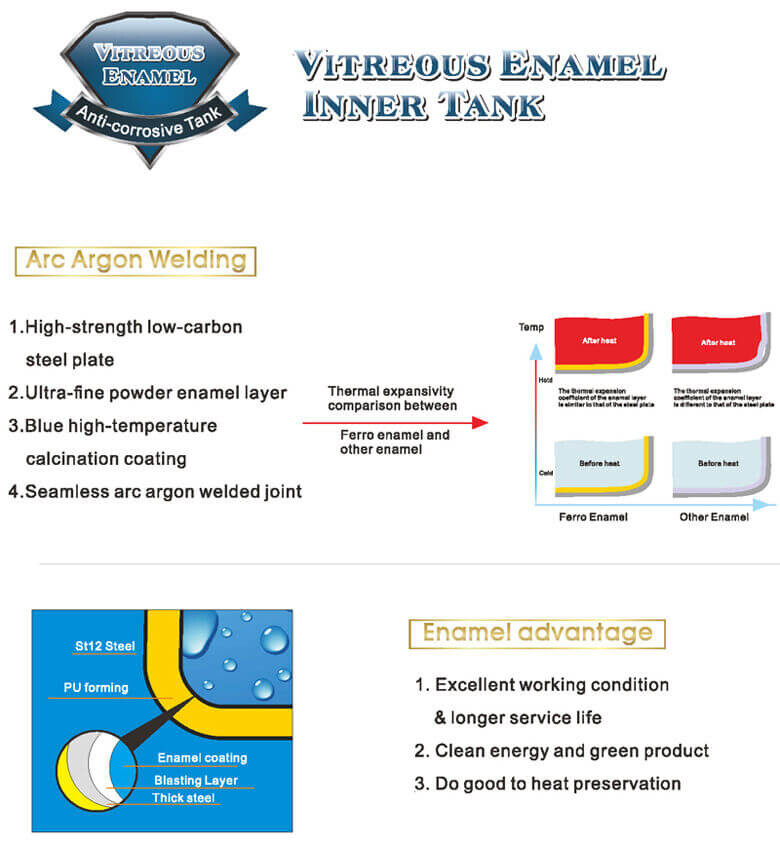
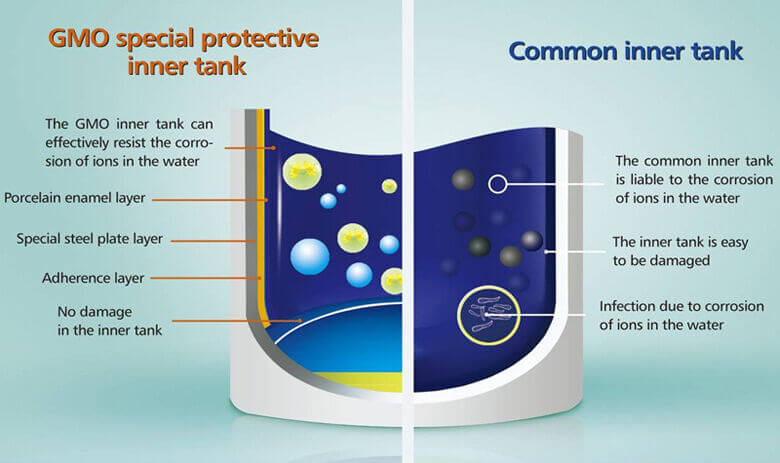
Downloads
Excellent working condition & longer service life: no leakage, rust-free, high strength and strong resistance to corrosion
Installation and manuals
Downloads
Excellent working condition & longer service life: no leakage, rust-free, high strength and strong resistance to corrosion
Product Catalogue
- Exporting Electric Water Heaters to Africa: Market Insights and Strategies
- Small-Capacity Electric Water Heaters in Africa: Market Preferences Across Key Countries
- How to know the quality of stainless steel electric heating element?
- What are the basic structures of stainless steel electric heating element?
- Let's Take A Look At The Inner Tank Material!
Warranty Information
Dingxin warrants for 2 years from the date of purchase, that the Product will: i) conform to Dingxin approval specification, ii) be free from defects in materials and workmanship, subject to conditions below. All electric components carry a 2-year warranty
Conditions
The Product is manufactured to suit most household water supplies. However, there are certain water chemistries (outlined below) that can have a detrimental effect on the Product and its life expectancy. If there are uncertainties regarding water quality, the local water supply authority can supply the necessary data. The warranty applies only if the conditions set out below are met in full:
• The Product has been installed by a professional installer, in accordance with the instructions in the installation manual and all relevant Codes of Practice and Regulations in force at the time of installation.
• The Product has not been modified in any way, tampered with or subjected to misuse and no factory fitted parts have been removed for unauthorized.
• Any disinfection has been carried out without affecting the Product in any way whatsoever. The Product shall be isolated from any system chlorination.
• The Product has been in regular use from the date of installation. If the Product is not intended to be used for 60 days or more, it must be drained.
• Service and/or repair shall be done according to the installation manual and all relevant codes of practice. Any replacement parts used shall be original DINGXIN i spare parts.
• Any third-party costs associated with any claim has been authorized in advance by DINGXIN in writing.
• The purchase invoice and/or installation invoice, a water sample as well as the defective product is made available to DINGXIN i upon request.
• Failure to follow these instructions and conditions may result in product failure, and water escaping from the Product.
Warranty Information
Dingxin warrants for 2 years from the date of purchase, that the Product will: i) conform to Dingxin approval specification, ii) be free from defects in materials and workmanship, subject to conditions below. All electric components carry a 2-year warranty
Limitations
The warranty does not cover:
• Any fault or costs arising from incorrect installation, incorrect application, lack of regular maintenance in accordance with the installation manual, neglect, accidental or malicious damage, misuse, any alteration, tampering or repair carried out by a non-professional, any fault arising from the tampering with or removal of any factory fitted safety components or measures.
• Any consequential damage or any indirect loss caused by any failure or malfunction of the Product whatsoever.
• Any pipework or any equipment connected to the Product.
• The effects of frost, lightning, voltage variation, lack of water, dry boiling, excess pressure or chlorination procedures.
• The effects of stagnant (de-aerated) water if the Product has been left unused for more than 60 days consecutively.
• Damage caused during transportation. Buyer shall give the carrier notice of such damage.
• Costs arising if the Product is not immediately accessible for servicing.
These warranties do not affect the Buyer’s statutory rights.
FAQ
Q1:How long does the order take?
A:Sample order will be finished within 15 days while normal order will be finished within 25-30 days after receiving deposit,
Q2:What are my WARRANTY OPTIONS on the water heaters you sell?
Dingxin Water Heater Company provides a basic, standard warranty. Our basic warranty is one year for full units or 1% spare parts service.
Q3:Do you accept OEM or ODM orders?
A:Yes, Our R&D team will offer one stop service for you from original idea to finished product.
Q4:What’s the MOQ?
A: Normally MOQ is 1*20 ft container(trial order's quantity is negotiable)
Q5:How can I visit your factory?
A: Sure,Our factory is located in Shaoxing Shengzhou, China, near to Hangzhou Airport and Ningbo Airport .You are always welcome to visit us! We will offer pick up service and free accomodation.
Q6:When can I get the price?
A:Within 24 hours after we get your inquiry.
Q7:Can you offer sample for quality check before order ?
A:Yes , we provide sample service before mass order.
Q8: what other size water heater you have ?
A: We have storage models of 8L\10L\15L\30L\50L\60L\80L\100L\120L\150L,and besides storage model,we also work on instant models,and gas models.
Q9: Can the price be cheaper?
A: Price always follows its quality and we will offer truthful opinion on the marketing strategy on pricing and quality orientation.
Q10: What payment terms?
A: T/T; L/C,West Union or other payment term negotiable
Please give us a message
